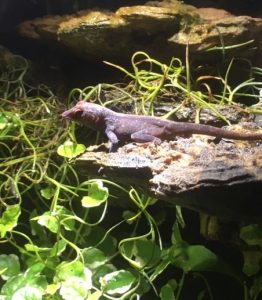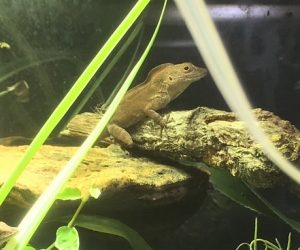Copyright 2021 Evolution Reptiles
All rights reserved.
Copyright 2025 Evolution Reptiles
All rights reserved.
All rights reserved.
Also known as the Puerto Rican anole, or the Puerto Rican crested anole this is a stocky, medium sized member of the anole family. Active and alert, this highly adaptable species can be found in rainforest, open woodland, farmland and even urban habitats; it is capable of changing its physiology to cope with different temperature ranges, which is a key part of its success in the modern world.
Males reach a snout to vent length (SVL) of 75mm (3”) with a tail at least as long as the body, with females up to 73mm (2.9”) although most females are much smaller. Colouration is extremely variable, bronze/green head with a body of olive green, brown, even near black and a light ash grey with faint, irregular brown spots. They can change colour according to mood, temperature and health status, leading to sometimes being called ‘chameleons’ although they are not related to the true chameleons. Males have a crest along the tail which is permanently raised, a smaller crest along the spine which gets larger again on the nape of the neck. A fully grown male displaying his neck and tail crests is an impressive sight, especially if he is flashing his brightly coloured dewlap at the same time.

There is an increasing supply of captive bred individuals as this charming species thrives in a well designed enclosure. They are an easy species to keep happy in captivity; in the wild, they live around the base of trees and shrubs, climbing high to bask, display and hunt. A tropical terrarium of at least 45 x 60cm (18” x 24”) – taller than it is wide – well furnished with branches and greenery will suit them very well. A good spray once a day will give them the humidity spike they need to shed and to keep their skin in good condition; they will drink from a water bowl, but they do like to lick droplets of water from leaves and branches. They can be excellent paludarium subjects, as they can swim!
Feeding is similar to most small insectivorous lizards – fruit flies and micro crickets for babies, up to medium sized crickets and locusts for adults. All live foods should be dusted with a good calcium or multivitamin/multimineral supplement.
Like all diurnal lizards, crested anoles should be provided with an efficient source of UVB light. They are often observed in the wild basking in sunny spots on their chosen tree, so to replicate this a good basking bulb should be used, with a UV strip lamp providing diffused UV coverage. As ever, there should be areas where your anoles can hide away, so provide plenty of leafy cover.

Temperatures should be as high as 35ºC (94ºF) directly under the basking spot, with an ambient temperature of 28 to 30ºC (84 to 86ºF) in the warm end. The cool end – which will be lower down in the terrarium – should be at 23 to 25ºC (74 to 78ºF), and the overall temperature at night can drop to as low as 20ºC (68ºF). If additional heating is needed at night, it can be provided with a thermostatically controlled deep heat projector attached to the top of the enclosure. Always keep an eye on your temperatures using a good quality digital thermometer.
Despite their rather flighty nature, they are an immensely curious species that do like to see what’s going on around them and with a little patience can be encouraged to hand feed. They are happiest when kept in a group of one male to several females – two males will fight unless they are in a particularly large environment. A happy and settled male will go through his behavioural range in full view, which makes a nice change from shy lizards that you have to spend half an hour searching for amidst the foliage!
Copyright 2021 Evolution Reptiles
All rights reserved.